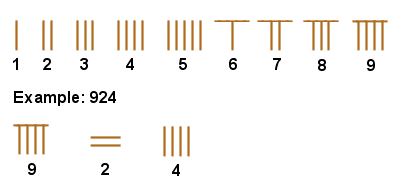
While mathematical progress in the ancient Greek world was starting to decline in the last centuries BCE, the expanding trade empire of China was propelling Chinese mathematics to new heights.
The Chinese Number System
The ancient Chinese numbering system, which can be traced back to at least the 2nd millennium BCE, was both simple and efficient. It utilized small bamboo rods organized to represent numbers from 1 to 9, which were then arranged in columns signifying units, tens, hundreds, thousands, and so on. This system, known as a decimal place value system, closely resembles the one in contemporary use today. Remarkably, the Chinese adopted this numerical system over a thousand years before it found its way to the Western world. Its implementation allowed for swift and straightforward execution of even relatively complex calculations.
In written numbers, however, a slightly less efficient method was employed. Here, distinct symbols represented tens, hundreds, thousands, and so forth. This approach arose largely due to the absence of the concept or symbol for zero, which, in turn, limited the versatility of written numbers in Chinese.
The use of the abacus, often associated with Chinese mathematics, though a Chinese innovation, has origins elsewhere. Variations of the abacus were used in Mesopotamia, Egypt, and Greece, likely preceding its adoption in China. The earliest known Chinese abacus, known as the “suanpan,” dates back to approximately the 2nd Century BCE.
Lo Shu magic square
Ancient China was marked by a profound fascination with numbers and mathematical patterns, with various numbers believed to possess cosmic significance. Among these, magic squares held a special place, characterized by squares of numbers where the sum of each row, column, and diagonal equaled the same total. These magic squares were esteemed for their spiritual and religious importance.
One of the earliest known magic squares is the Lo Shu Square, an order three square in which every row, column, and diagonal adds up to 15. It dates back to approximately 650 BCE, with a legendary tale of Emperor Yu’s discovery of the square on the back of a turtle, set around 2800 BCE. As time progressed, more substantial magic squares emerged, showcasing even greater mystical and mathematical properties. This journey culminated in the intricate magic squares, circles, and triangles created by Yang Hui in the 13th Century. Yang Hui’s contributions extended beyond magic squares; he also devised a triangular representation of binomial coefficients, identical to the later Pascal’s Triangle, and may have been among the first to employ decimal fractions in their modern form.
Early Chinese Method of Solving Equations
The primary focus of Chinese mathematics during ancient times was driven by the empire’s increasing demand for administrators with strong mathematical skills. A textbook titled “Jiuzhang Suanshu” or “Nine Chapters on the Mathematical Art,” authored over a period starting around 200 BCE, likely by various contributors, played a pivotal role in the education of civil servants. This comprehensive text addressed hundreds of practical problems related to trade, taxation, engineering, and wage calculations.
A notable aspect of the “Nine Chapters” was its emphasis on solving equations, involving the deduction of unknown values from known information. It employed a sophisticated matrix-based approach that wouldn’t resurface in the West until Carl Friedrich Gauss rediscovered it in the early 19th Century, now known as Gaussian elimination.
Liu Hui, one of the most prominent mathematicians in ancient China, made significant contributions by producing a detailed commentary on the “Nine Chapters” in 263 CE. He was among the first mathematicians to refrain from approximating roots, aiming for more precise results. By employing an approximation method using a regular polygon with 192 sides, Liu Hui devised an algorithm that calculated the value of π as 3.14159 (accurate to five decimal places). Additionally, he pioneered an early form of both integral and differential calculus.
The Chinese Remainder Theorem
The Chinese didn’t stop at solving relatively simple equations described in the “Nine Chapters.” They ventured into tackling much more intricate equations involving significantly larger numbers. They also delved into abstract mathematical problems, although they often framed them within practical contexts. One notable achievement was the development of what we now recognize as the Chinese Remainder Theorem. This theorem leveraged the remainders obtained when dividing an unknown number by a sequence of smaller numbers, such as 3, 5, and 7, to determine the smallest possible value of the unknown number. This technique, initially proposed by Sun Tzu in the 3rd Century CE, is considered a gem in mathematics. Chinese astronomers in the 6th Century AD applied it to measure planetary movements, and even today, it finds practical applications, including in Internet cryptography.
During the Golden Age of Chinese mathematics in the 13th Century, there were more than 30 prestigious mathematics schools scattered across China. Among the most brilliant Chinese mathematicians of this era was Qin Jiushao, a somewhat notorious figure as an imperial administrator and warrior, known for his violence and corruption. He explored solutions to quadratic and even cubic equations using a method of repeated approximations, strikingly similar to the one later devised in the West by Sir Isaac Newton in the 17th Century. Qin’s innovation even extended to solving equations involving numbers raised to the power of ten, demonstrating extraordinary mathematical sophistication for his time.


